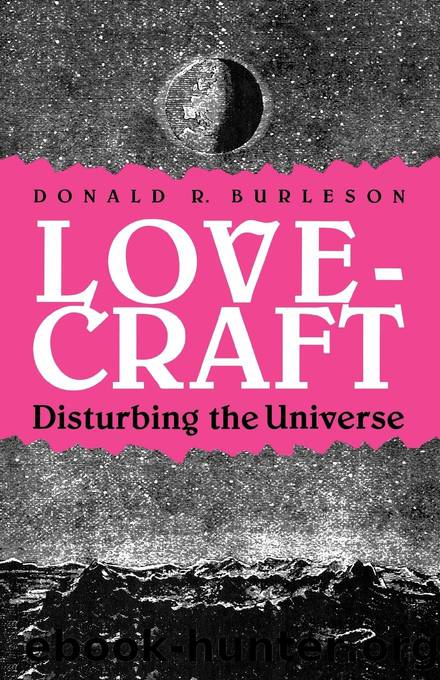Lovecraft by Donald R. Burleson;

Author:Donald R. Burleson; [Burleson, Donald R.]
Language: eng
Format: epub
ISBN: 9780813182612
Publisher: UP of Kentucky
Published: 2021-09-15T00:00:00+00:00
9. âPickmanâs Modelâ
The year 1926 saw the writing of H.P. Lovecraftâs âportrait of the artist,â not in the Joycean sense necessarily. This fictional portrayal of a painter of weird canvases is called âPickmanâs Modelâ (DUN, 12-25). The narrator, whom we know only as Thurber, relates the tale as if speaking to an art club acquaintance whom he addresses as Eliot. Evidently Eliot has asked the narrator why it is that the artist Richard Upton Pickman, a person of odd repute at the art club, has recently vanished. The narrator regales Eliot with remarks about Pickmanâs exceedingly weird and morbid art, canvases (exemplified by one called âGhoul Feedingâ) that have shocked and alienated other members of the club. Thurber tells Eliot that he has visited Pickman and heard that outré artistâs wild theories of horrific art and its inspirational sources.
Pickman, in a flashback subnarration, explains to Thurber that in a regular Back Bay Boston environment there are âthings that are out of place here, and that canât be conceived here, anyhowâ (15). Pickman reveals that he has rented, under an assumed name, a studio in the crumbling and archaic alleys of Bostonâs North End, where he takes the curious Thurber and shows him hideous but brilliant paintings âquite beyond the power of words to classifyâ (18). The dominant subjects of the paintings seem to be ghoulish creatures with âa vaguely canine castâ and a facial texture of ârubberiness.â Yet the backgrounds are not phantasmal or extramundane dreamworlds; rather, they are commonplace local scenes, including the nearby Coppâs Hill Burying Ground.
Pickman, in his hidden studio, paints in the cellar, âwhere the inspiration is thickestâ (17), with artificial light. There is in one room in this cellar a large circular well plugged by a heavy wooden disk. Pickman, having taken the visiting narrator to an adjoining room (the studio), seems to hear something that disturbs him and goes to investigate. Thurber hears shots, and Pickman returns, explaining that the problem is rats. Yet the suggestion grows that this explanation is specious. Thurber has noticed a curled-up piece of paper tacked to a canvas-in-progress and has assumed that it is a photograph of a mundane background that Pickman intends to paint behind the revolting figure on the easel. In the excitement of hearing the shots, Thurber, fingering the piece of paper and intending to ask the artist about it, absentmindedly pockets it, and soon thereafter he leaves. Now Pickman has disappeared, and Thurber reveals to Eliot what was on the paper that had been pinned to the unfinished paintingânot the photograph of an intended background, but a photograph of the ghoulish figure itself: âIt was the model he was usingâand its background was merely the wall of the cellar studio in minute detail. But by God, Eliot, it was a photograph from lifeâ (25). In this rather engaging tale, this portraiture of a portraiture, we shall of course find that the surface pigments are not all that the canvas holds.
At the outset one notes
Download
This site does not store any files on its server. We only index and link to content provided by other sites. Please contact the content providers to delete copyright contents if any and email us, we'll remove relevant links or contents immediately.
The Power of Myth by Joseph Campbell & Bill Moyers(925)
Half Moon Bay by Jonathan Kellerman & Jesse Kellerman(911)
A Social History of the Media by Peter Burke & Peter Burke(880)
Inseparable by Emma Donoghue(844)
The Nets of Modernism: Henry James, Virginia Woolf, James Joyce, and Sigmund Freud by Maud Ellmann(739)
The Spike by Mark Humphries;(719)
A Theory of Narrative Drawing by Simon Grennan(706)
The Complete Correspondence 1928-1940 by Theodor W. Adorno & Walter Benjamin(703)
Ideology by Eagleton Terry;(659)
Bodies from the Library 3 by Tony Medawar(648)
Culture by Terry Eagleton(646)
World Philology by(645)
Farnsworth's Classical English Rhetoric by Ward Farnsworth(641)
A Reader’s Companion to J. D. Salinger’s The Catcher in the Rye by Peter Beidler(614)
Adam Smith by Jonathan Conlin(607)
High Albania by M. Edith Durham(592)
Game of Thrones and Philosophy by William Irwin(592)
Comic Genius: Portraits of Funny People by(581)
Monkey King by Wu Cheng'en(575)
